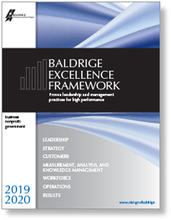Blogrige
The Official Baldrige Blog

I recently have seen some startling statistics from Gallup and Glassdoor about employee and customer engagement. I hope those statistics do not represent data from any organization you or I associate with. The actions of senior leaders and setting the right focus on employees can avoid your organization from becoming a "startling statistic." The Baldrige Criteria for Performance Excellence ask the questions that can guide your organization in the right direction.
I have six data points to share my grave concern:
- Only 22% of employees strongly agree their leaders set a clear vision for their organization.
- Only 26% of employees believe their organization always delivers on customer commitments.
- Only 14% of employees strongly agree that the performance reviews they receive inspire them to improve.
- 67% of employees say they are burned out at work.
- 81% of employees would work harder if their bosses expressed more gratitude.
- 51% of currently employed adults in the U.S. say they are searching for new jobs or watching for new job opportunities.
Only 22% of Employees Strongly Agree Their Leaders Set a Clear Vision for Their Organization.
I believe there are two aspects to this issue. The first is about senior leaders setting a compelling vision for the organization. The second issue relates to communicating that vision and engaging employees in achieving it. The Senior Leadership itemin the Baldrige Criteria asks how senior leaders set and deploy the organization's vision. It further asks how they create an environment for success now and in the future.
Only 26% of Employees Believe Their Organization Always Delivers on Customer Commitments.
I believe there are multiple aspects to this issue.
- The first possibility is that customer expectations and "delighters" have never been ascertained because of lack of communication with customers.
- The second possibility is that the expectations are known by leaders but not communicated to employees.
- The third possibility is that senior leaders do not place a focus on customer engagement.
- The fourth possibility is that the expectations and "delighters" are known, but complaints are unaddressed, not analyzed for patterns (to mitigate future complaints), or that employees are not empowered to solve customer complaints or requests.
- The final possibility is that expectations are met, but competitors deliver a greater level of satisfaction and engagement.
The Organizational Profile of the Baldrige Criteria asks for your key customer requirements and expectations, and how they differ for different customer groups. The Senior Leadership item in the Baldrige Criteria asks how senior leaders set a focus on customer engagement and creating customer value.
The Customers category of the Baldrige Criteria has a whole item that addresses listening to customers to determine their needs and another item that addresses building relationships with customers and determining their satisfaction and engagement, including managing any complaints.
The Workforce Environment item asks how you organize and manage your workforce to reinforce a customer focus. The Workforce Engagement item asks how your workforce performance management system supports a customer focus.
Only 14% of Employees Strongly Agree That the Performance Reviews They Receive Inspire Them to Improve.
Many employees don't believe the performance reviews are fair. They believe that there is favoritism in review systems. And frequently mandated review criteria do not match the key attributes of an employee's job performance. The Baldrige Criteria have an item that addresses Workforce Engagement and includes how your performance management system supports high performance, how you support personal development of employees, and how you manage career progression for your employees.
67% of Employees Say They Are Burned Out at Work.
Employee burnout can impact organizational performance, organizational culture, and customer engagement. The Organizational Profile asks about drivers of employee engagement for your employees. The Workforce Engagement item asks how those drivers differ for workforce groups and segments and how you foster an organizational culture that is characterized by an engaged workforce.
81% of Employees Would Work Harder if Their Bosses Expressed More Gratitude.
How often do your bosses say "thank you" to employees? The Senior Leadership item asks how senior leaders communicate with the entire workforce and foster frank, two-way communication. It also asks how they take a direct role in motivating the workforce toward high performance.
51% of Currently Employed Adults in the U.S. Say They Are Searching for New Jobs or Watching for New Job Opportunities.
The Workforce category of the Baldrige Criteria is all about setting the proper environment to support the workforce, engage and develop workforce members and thereby build loyalty and commitment to the organization.
Do You Have the Data for Your Organization?
Are you part of these startling statistics? Have you asked yourselves some of the questions posed by the Baldrige Criteria? Consider using the Baldrige Excellence Framework or starting with the Baldrige Excellence Builder to make sure you are a high-performing organization and not a startling statistic.
Learn From Role Model Organizations
If you want to see how high performing organizations engage employees and achieve high performance, and financial and customer success, consider learning from organizations that have achieved role model status through the Malcolm Baldrige National Quality Award. They will be presenting their strategies at the 2019 Baldrige Fall Conference in Nashville, TN on October 24-25, 2019. I look forward to seeing you there!
A Systems Approach to Improving Your Organization’s Performance

Baldrige Excellence Framework
The Baldrige Excellence Framework has empowered organizations to accomplish their missions, improve results, and become more competitive. It includes the Criteria for Performance Excellence, core values and concepts, and guidelines for evaluating your processes and results.
Purchase your copy today!
Available versions: Business/Nonprofit, Education, and Health Care
About the author
Related Posts
Comments
Segmentation of these aggregate metadata points would provide pointers to help sort out the probabilities along the branches of Dr. Hertz's decision tree. Something as simple and easy as using the Baldrige "Are We Making Progress?" series would uncover some of the specific gaps between employee and leadership perceptions that generate such data as these.






This is a remarkable article. I thank Dr. Hertz for preparing it and sharing it with the rest of us. I have found these statistics to be true in different kinds of organizations where I have served as a senior leader. I have observed that HOW employees are led and treated make a world of difference in their performance and the success of the organization.
These statistics certainly reflect my experiences.
Reatha King
Member, Baldrige Board of Overseers